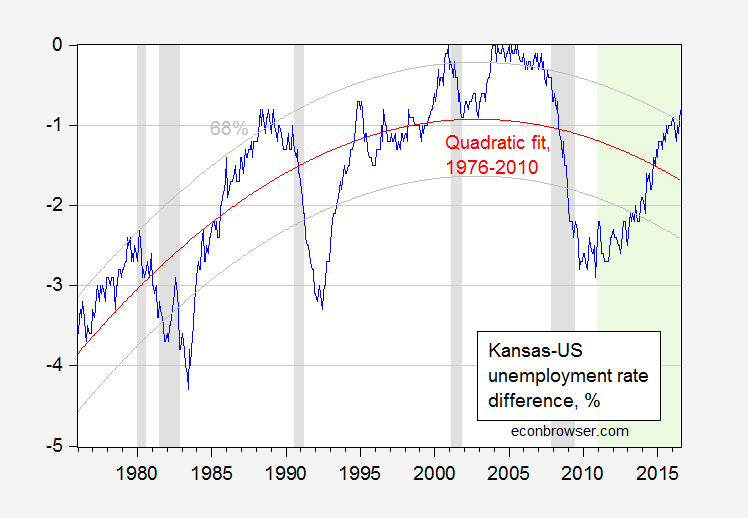Bryan Kelly at the University of Chicago, Hanno Lustig at Stanford and Stijn van Nieuwerburgh at NYU had an interesting paper in the June issue of American Economic Review that used option prices to measure the magnitude of the implicit U.S. government guarantee of the financial sector during 2007-2009.
Continue reading
More on the Kansas-US Unemployment Rate Difference
Bruce Hall says changing dynamics in Kansas have meant that a simple average difference (what I’ve called a individual state fixed effect) in Kansas-US unemployment rates is misleading — or more succinctly put, “the average obfuscates the trend”. So, I allowed a time trend and a square in time trend, in a regression over the 1976-2010 period (data series start in 1976; Brownback takes power in 2011). The t-stats on both coefficients are highly significant. Here is a picture of actual Kansas-US difference and the quadratic trend.
Figure 1: Kansas-US unemployment rate difference, in %, seasonally adjusted (blue), and quadratic fit (red), and 68% prediction interval (gray). NBER defined recession dates shaded gray. Out of sample period shaded green. Source: BLS, NBER, author’s calculations.
Kansas Employment Declines
Bruce Bartlett alerts me to the continuing economic downturn in the state.
Kansas and Wisconsin Unemployment in Historical Perspective
Reader Bruce Hall asserts the two states aren’t doing too badly in terms of unemployment rates.
Wisconsin Employment for July
With update 8/23 showing application of same methodology to Doyle administrations.
DWD released data today. Wisconsin private employment in July is estimated to equal what we earlier thought it was in June…
Recession Watch, August 2016 Updated
New data came out on industrial production and monthly GDP over the last couple days. That allows us to update the picture of key indicators that the NBER Business Cycle Dating Committee focuses on continues to paint an ambiguous picture.
“Balance Sheet Effects on Monetary and Financial Spillovers: The East Asian Crisis Plus 20”
That’s the title of a new paper written by me, Joshua Aizenman and Hiro Ito:
Why you should never use the Hodrick-Prescott filter
A common problem in economics is that most of the variables we study have trends. Even the simplest statistics like the mean and variance aren’t meaningful descriptions of such variables. One popular approach is to remove the trend using the Hodrick-Prescott filter. I’ve just finished a new research paper highlighting the problems with this approach and suggesting what I believe is a better alternative.
Continue reading
Does the Aerospace Decline Explain the Kansas Collapse?
Ironman at Political Calculations thinks so. Unfortunately, in his calculation of Kansas GDP excluding agriculture and manufacturing, he made an error by simply subtracting (chain weighted) real agricultural output and real manufacturing from real GDP (as discussed in the addendum to this post; note that Ironman has never to my knowledge acknowledged this error). I’ll re-examine the importance of the shocks to the aerospace industry in Kansas to the slow pace of Kansas growth by looking at contributions to GDP growth, and contributions to employment growth.
